Tensile Failure Behaviors of Adhesively Bonded Structure Based on In Situ X-ray CT and FEA
Abstract
:1. Introduction
2. Experimental Method
2.1. In Situ X-ray Micro-CT under Tensile
2.2. Chromatographic Image Processing and 3D Reconstruction
2.3. Finite Element Modeling
3. Results and Discussion
3.1. Micro-Failure Mechanisms Based on In Situ X-ray Micro-CT
3.2. Finite Element Analysis
4. Conclusions
- In situ X-ray micro-CT tensile test monitored the comprehensive process of tensile failure in adhesively bonded structures in real time. Based on three-dimensional reconstruction technology, the microstructures of the adhesive layer across different stages of the tensile process—initial, stretching, and fracture phases—were visible.
- In the initial phase, naturally formed pores within the adhesive layer predominantly exhibited an ellipsoidal morphology. As load was applied, these pore structures transformed from an ellipsoid to a flat ellipsoid in the same direction as the stress, and the sphericity significantly diminished.
- Macrocracks started at the gap created by the pores and propagated along the pores’ path. Microcracks developed from crack connections between the pores. This phenomenon arose due to stress concentration in areas with pore defects, leading to crack initiation near these pores. Once the tip crack was generated, it would continue to expand inward along the stress concentration area, and then spread to the adhesive layer far away from the pore defects, eventually leading to the tensile failure.
- The results of the FEA revealed stress concentrations near the pores, progressively linking during the tensile process, thereby initiating cracks. The shape of the pores minimally impacted stress, whereas the size of the pores significantly influenced stress distribution, because as the defect size increased, more load was transferred by the remaining adhesive layer near the pores.
Author Contributions
Funding
Institutional Review Board Statement
Informed Consent Statement
Data Availability Statement
Conflicts of Interest
References
- Baldan, A. Adhesion phenomena in bonded joints. Int. J. Adhes. Adhes. 2012, 38, 95–116. [Google Scholar] [CrossRef]
- Komvopoulos, K. Adhesion and friction forces in microelectromechanical systems: Mechanisms, measurement, surface modification techniques, and adhesion theory. J. Adhes. Sci. Technol. 2003, 17, 477–517. [Google Scholar] [CrossRef]
- Lo, C.T.; Laabs, F.C.; Narasimhan, B. Interfacial adhesion mechanisms in incompatible semicrystalline polymer systems. J. Polym. Sci. Pol. Phys. 2004, 42, 2667–2679. [Google Scholar] [CrossRef]
- Shang, X.; Marques, E.A.S.; Machado, J.J.M.; Carbas, R.J.C.; Jiang, D.; Da Silva, L.F.M. Review on techniques to improve the strength of adhesive joints with composite adherends. Compos. Part B Eng. 2019, 177, 107363. [Google Scholar] [CrossRef]
- Ouyang, X.; Chen, C. Research on the joining of aluminum alloy and high-strength steel by dieless clinched-adhesive processes. J. Mater. Res. Technol. 2023, 24, 5526–5540. [Google Scholar] [CrossRef]
- Adams, R. A review of defect types and nondestructive testing techniques for composites and bonded joints. NDT&E Int. 1988, 21, 208–222. [Google Scholar]
- Chew, H.B.; Guo, T.F.; Cheng, L. Influence of Nonuniform Initial Porosity Distribution on Adhesive Failure in Electronic Packages. IEEE T Compon. Pack T 2008, 31, 277–284. [Google Scholar] [CrossRef]
- Zhang, T.; Meng, J.; Pan, Q.; Sun, B. The influence of adhesive porosity on composite joints. Compos. Commun. 2019, 15, 87–91. [Google Scholar] [CrossRef]
- Fame, C.M.; Ramôa Correia, J.; Ghafoori, E.; Wu, C. Damage tolerance of adhesively bonded pultruded GFRP double-strap joints. Compos. Struct. 2021, 263, 113625. [Google Scholar] [CrossRef]
- Ghasemvand, M.; Behjat, B.; Ebrahimi, S. Experimental investigation of the effects of adhesive defects on the strength and creep behavior of single-lap adhesive joints at various temperatures. J. Adhes. 2023, 99, 1227–1243. [Google Scholar] [CrossRef]
- Elhannani, M.; Madani, K.; Legrand, E.; Touzain, S.; Feaugas, X. Numerical analysis of the effect of the presence, number and shape of bonding defect on the shear stresses distribution in an adhesive layer for the single-lap bonded joint; Part 1. Aerosp. Sci. Technol. 2017, 62, 122–135. [Google Scholar] [CrossRef]
- Carrere, N.; Doitrand, A.; Martin, E.; Leguillon, D. Theoretical study based on 2D assumptions of the influence of small pores on crack initiation in adhesively bonded joints. Int. J. Adhes. Adhes. 2021, 111, 102979. [Google Scholar] [CrossRef]
- Maire, E. X-ray Tomography Applied to the Characterization of Highly Porous Materials. Annu. Rev. Mater. Res. 2012, 42, 163–178. [Google Scholar] [CrossRef]
- Gad, S.I.; Attia, M.A.; Hassan, M.A.; El Shafei, A.G. A random microstructure-based model to study the effect of the shape of reinforcement particles on the damage of elastoplastic particulate metal matrix composites. Ceram. Int. 2021, 47, 3444–3461. [Google Scholar] [CrossRef]
- Du Plessis, A.; Yadroitsava, I.; Yadroitsev, I. Effects of defects on mechanical properties in metal additive manufacturing: A review focusing on X-ray tomography insights. Mater. Des. 2020, 187, 108385. [Google Scholar] [CrossRef]
- Dumont, V.; Badulescu, C.; Stamoulis, G.; Adrien, J.; Maire, E.; Lefèvre, A. On the influence of mechanical loadings on the porosities of structural epoxy adhesives joints by means of in-situ X-ray microtomography. Int. J. Adhes. Adhes. 2020, 99, 102568. [Google Scholar] [CrossRef]
- Hu, X.; Fang, J.; Xu, F.; Dong, B.; Xiao, Y.; Wang, L. Real internal microstructure based key mechanism analysis on the micro-damage process of short fibre-reinforced composites. Sci. Rep. 2016, 6, 34761. [Google Scholar] [CrossRef]
- Ge, L.; Li, H.; Zhong, J.; Zhang, C.; Fang, D. Micro-CT based trans-scale damage analysis of 3D braided composites with pore defects. Compos. Sci. Technol. 2021, 211, 108830. [Google Scholar] [CrossRef]
- Zhang, D.; Liu, Y.; Liu, H.; Feng, Y.; Guo, H.; Hong, Z. Characterisation of damage evolution in plain weave SiC/SiC composites using in situ X-ray micro-computed tomography. Compos. Struct. 2021, 275, 114447. [Google Scholar] [CrossRef]
- Niu, B.; Shen, H.; Li, T.; Zhang, H.; Qian, Z.; Cao, Y. 2.5D quartz fabric reinforced nanoporous phenolic composites with weakened heat transfer and optimized mechanical properties. Compos. Sci. Technol. 2022, 230, 109726. [Google Scholar] [CrossRef]
- Tong, W.M.; Bai, S.J.; Xing, H.; Nie, Y.S. Research on the Application of RTV566 Adhesive in Space Infrared Cryogenic Lens. Infrared 2021, 42, 17–24. [Google Scholar]
- Stricher, A.M.; Rinaldi, R.G.; Barrès, C.; Ganachaud, F.; Chazeau, L. How I met your elastomers: From network topology to mechanical behaviours of conventional silicone materials. RSC Adv. 2015, 5, 53713–53725. [Google Scholar] [CrossRef]
- Li, X.; Tian, C.; Li, H.; Liu, X.; Zhang, L.; Hong, S. Combined effect of volume fractions of nanofillers and filler-polymer interactions on 3D multiscale dispersion of nanofiller and Payne effect. Compos. Part A Appl. Sci. Manuf. 2022, 152, 106722. [Google Scholar] [CrossRef]
- Mooney, M. A Theory of Large Elastic Deformation. J. Appl. Phys. 1940, 11, 582–592. [Google Scholar] [CrossRef]
- Wadell, H. Volume, Shape, and Roundness of Quartz Particles. J. Geol. 1935, 43, 250–280. [Google Scholar] [CrossRef]
- Yang, H.; Xiao, R.; Yang, Z.; Lei, D. Experimental characterization and finite element modeling the deformation behavior of rubbers with geometry defects. Polym. Test. 2019, 80, 106111. [Google Scholar] [CrossRef]
- Sam-Daliri, O.; Faller, L.-M.; Farahani, M.; Roshanghias, A.; Araee, A.; Baniassadi, M.; Oberlercher, H.; Zangl, H. Impedance analysis for condition monitoring of single lap CNT-epoxy adhesive joint. Int. J. Adhes. Adhes. 2019, 88, 59–65. [Google Scholar] [CrossRef]
- Sam-Daliri, O.; Faller, L.-M.; Farahani, M.; Zangl, H. Structural health monitoring of adhesive joints under pure mode I loading using the electrical impedance measurement. Eng. Fract. Mech. 2021, 245, 107585. [Google Scholar] [CrossRef]
- Ghabezi, P.; Farahani, M. Composite Adhesive-Bonded Joint Reinforcement by Incorporation of Nano-Alumina Particles. J. Appl. Comput. Mech. 2017, 47, 231–239. [Google Scholar]
- Adhikari, K.; Baral, S.; Kumar, S.; Behera, R.K. Experimental study of the influence of pre-embedded defect shape and size on the performance of adhesively bonded single lap joints using Al-6061 adherends. Mater. Today Proc. 2023. [Google Scholar] [CrossRef]
- Karachalios, E.F.; Adams, R.D.; Da Silva Lucas, F.M. Strength of single lap joints with artificial defects. Int. J. Adhes. Adhes. 2013, 45, 69–76. [Google Scholar] [CrossRef]
- Crocombe, A.D. Global yielding as a failure criterion for bonded joints. Int. J. Adhes. Adhes. 1989, 9, 145–153. [Google Scholar] [CrossRef]
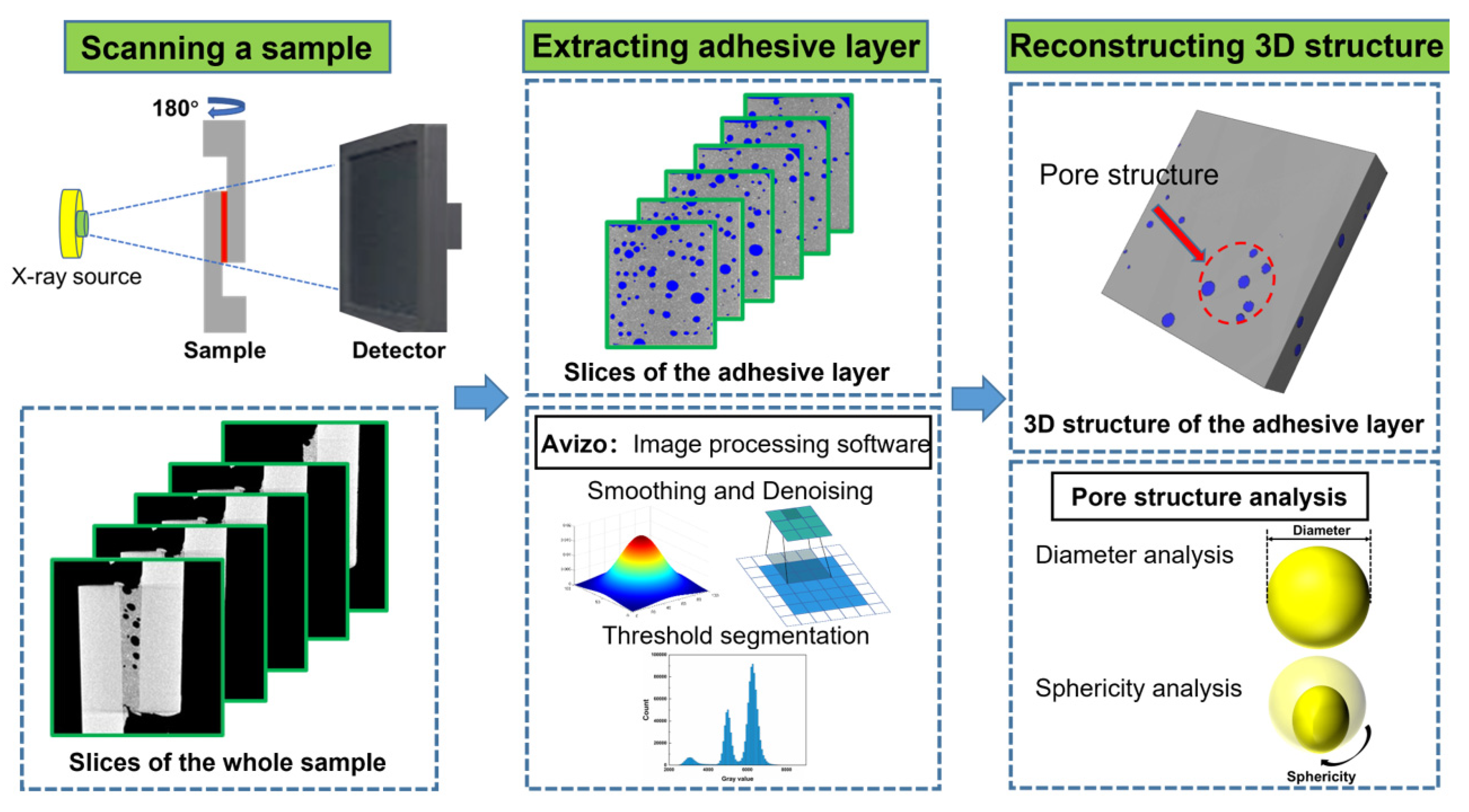


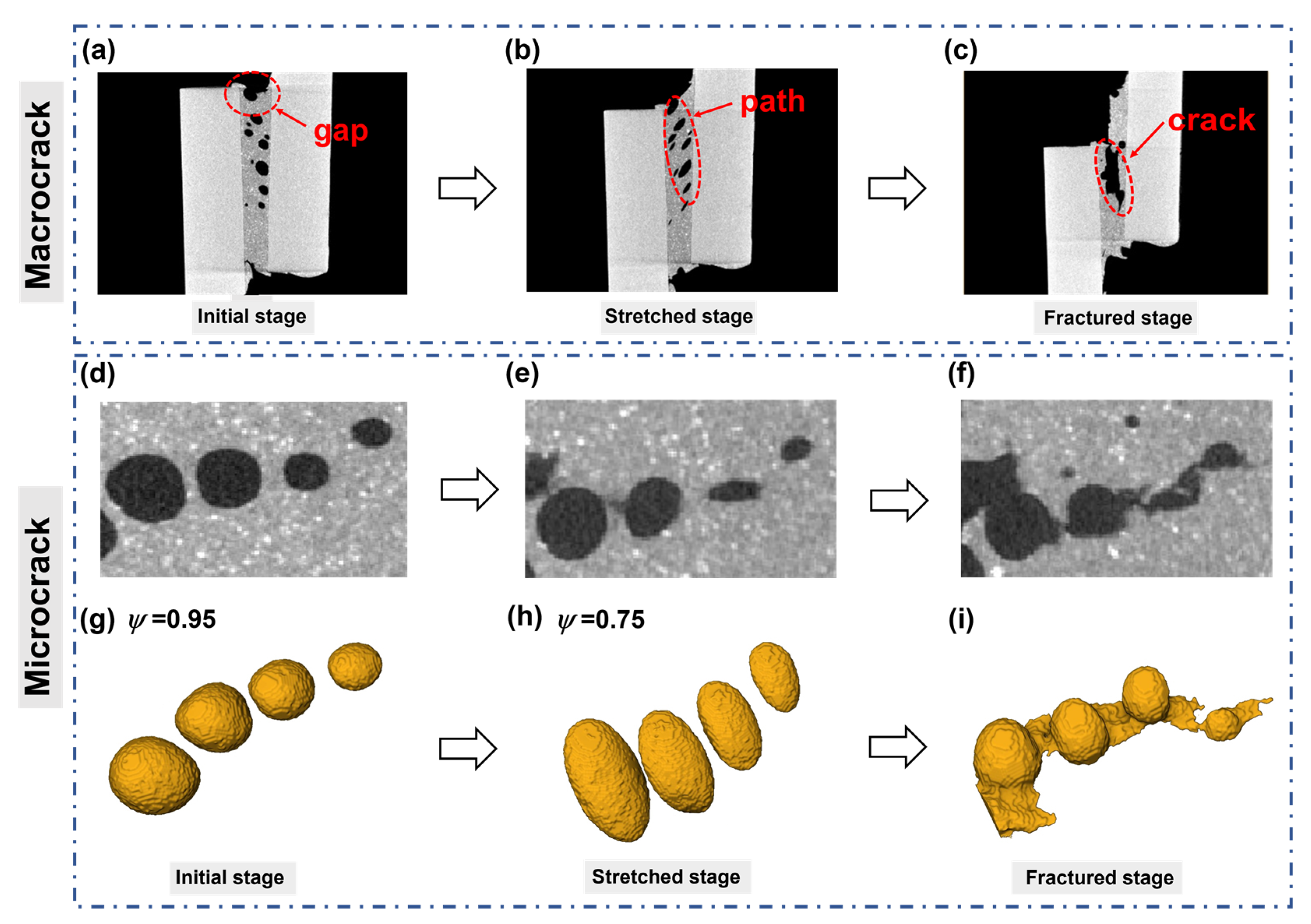

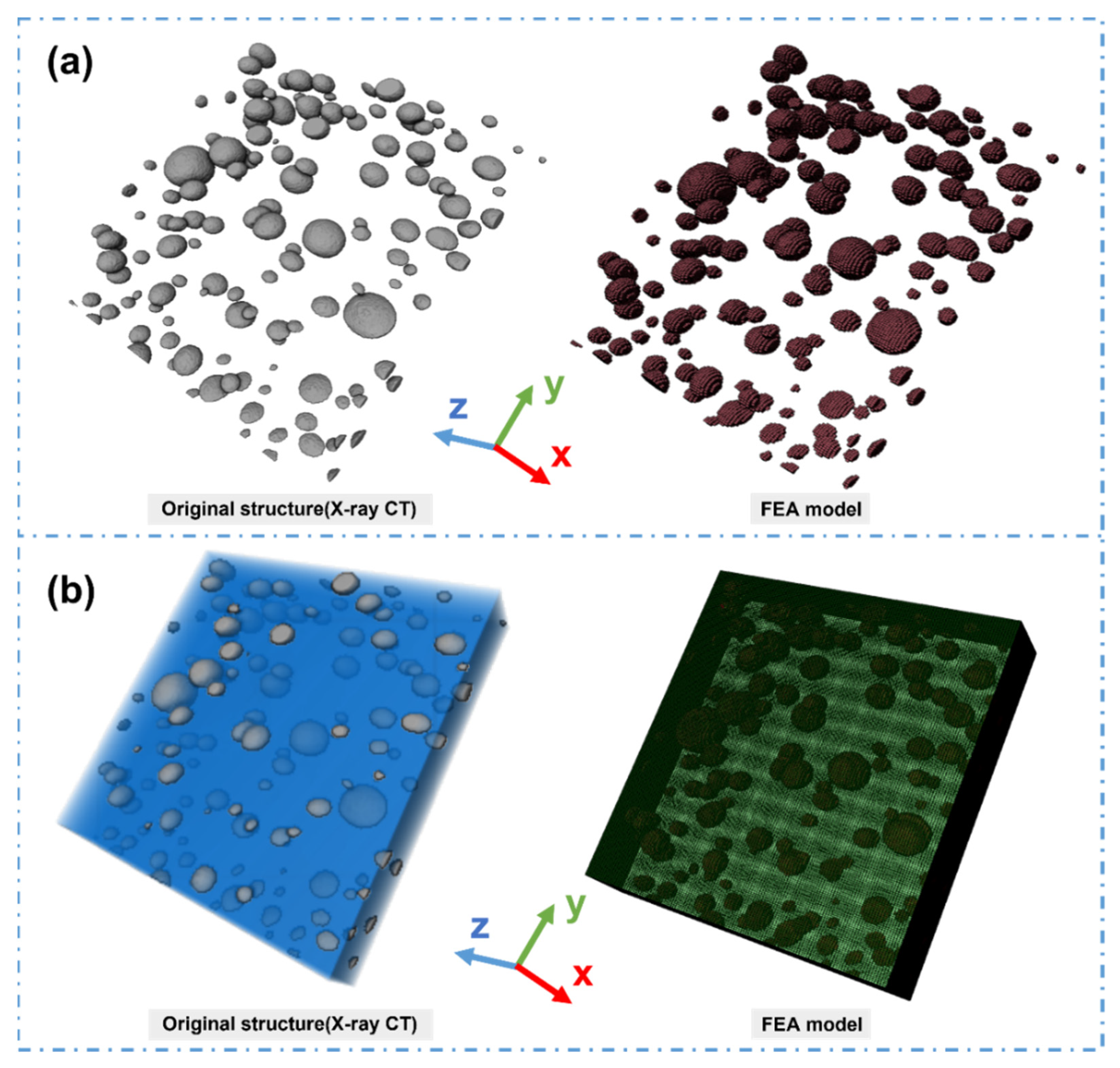
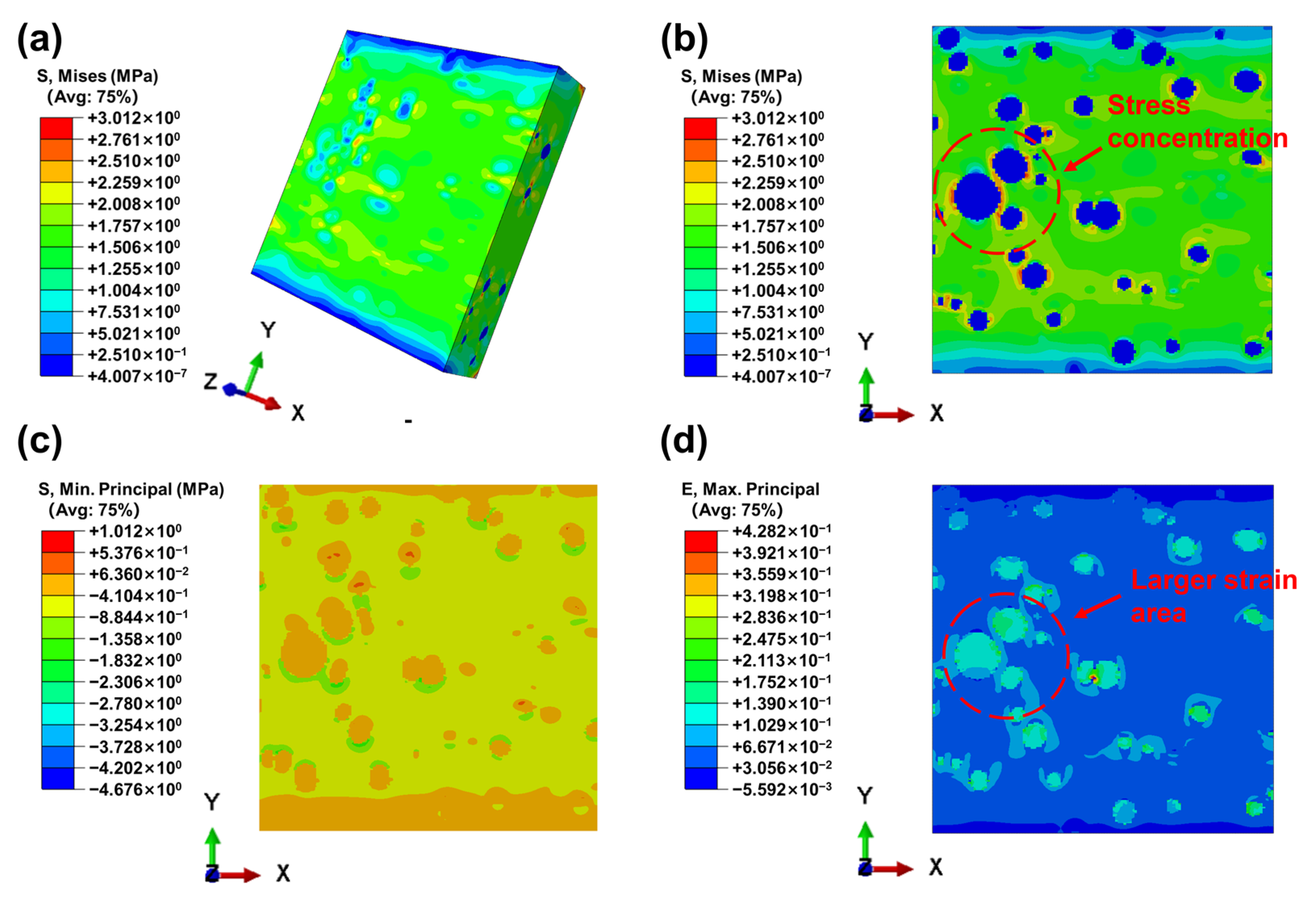

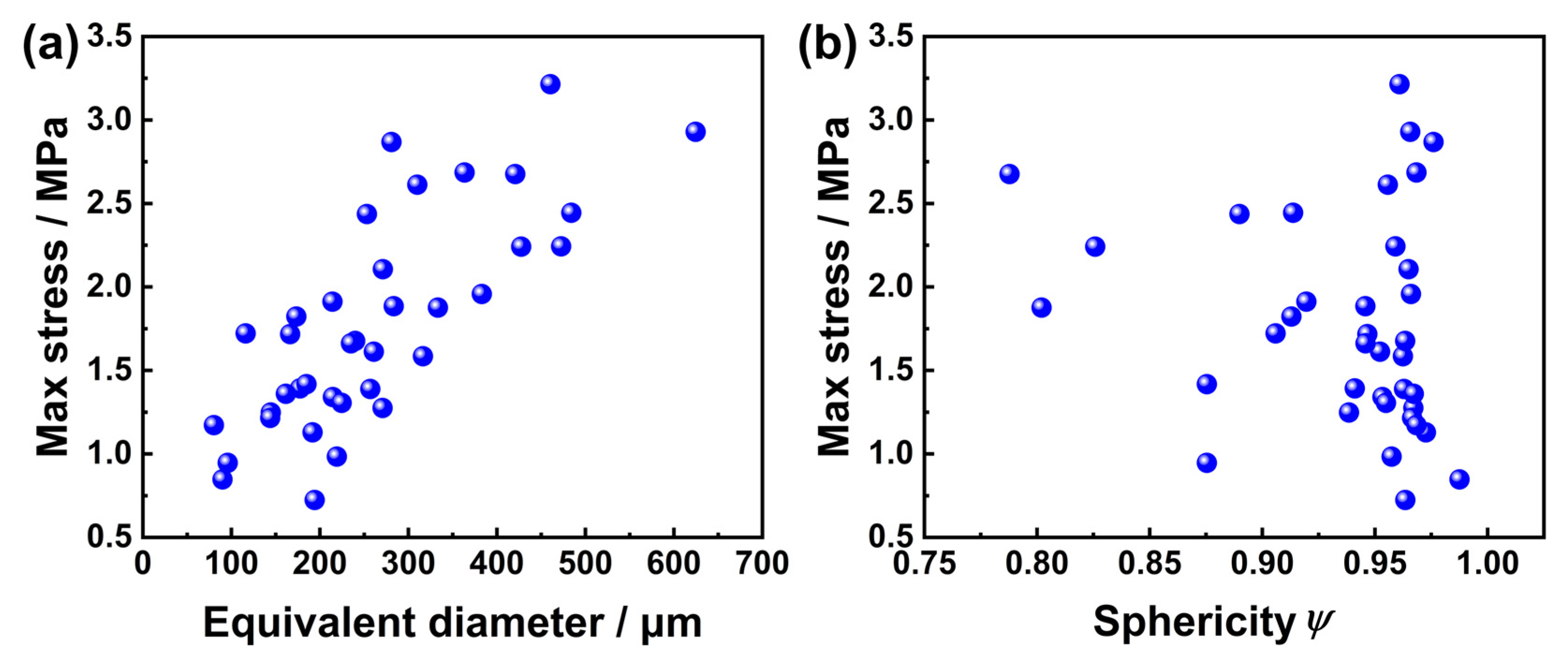
Disclaimer/Publisher’s Note: The statements, opinions and data contained in all publications are solely those of the individual author(s) and contributor(s) and not of MDPI and/or the editor(s). MDPI and/or the editor(s) disclaim responsibility for any injury to people or property resulting from any ideas, methods, instructions or products referred to in the content. |
© 2023 by the authors. Licensee MDPI, Basel, Switzerland. This article is an open access article distributed under the terms and conditions of the Creative Commons Attribution (CC BY) license (https://creativecommons.org/licenses/by/4.0/).
Share and Cite
Tang, J.; Niu, B.; Cao, Y.; Zhang, Y.; Long, D. Tensile Failure Behaviors of Adhesively Bonded Structure Based on In Situ X-ray CT and FEA. Materials 2023, 16, 7609. https://doi.org/10.3390/ma16247609
Tang J, Niu B, Cao Y, Zhang Y, Long D. Tensile Failure Behaviors of Adhesively Bonded Structure Based on In Situ X-ray CT and FEA. Materials. 2023; 16(24):7609. https://doi.org/10.3390/ma16247609
Chicago/Turabian StyleTang, Jiawen, Bo Niu, Yu Cao, Yayun Zhang, and Donghui Long. 2023. "Tensile Failure Behaviors of Adhesively Bonded Structure Based on In Situ X-ray CT and FEA" Materials 16, no. 24: 7609. https://doi.org/10.3390/ma16247609
APA StyleTang, J., Niu, B., Cao, Y., Zhang, Y., & Long, D. (2023). Tensile Failure Behaviors of Adhesively Bonded Structure Based on In Situ X-ray CT and FEA. Materials, 16(24), 7609. https://doi.org/10.3390/ma16247609





